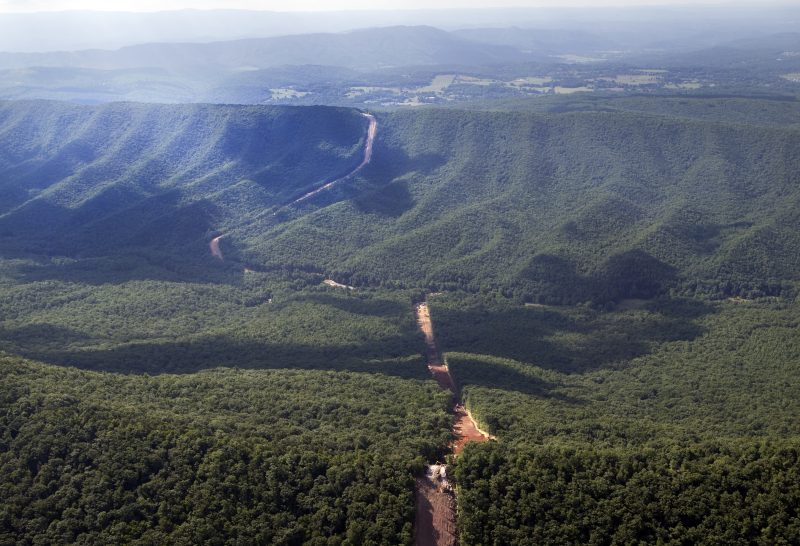The Supreme Court on Thursday cleared the way to complete a controversial Mid-Atlantic natural gas pipeline, agreeing that Congress greenlighted the project as part of a behind-the-scenes deal to raise the nation’s debt ceiling.
The justices lifted a lower court’s halt on the remaining construction of the Mountain Valley Pipeline, which will stretch 300 miles through rugged mountains in West Virginia and Virginia. Environmentalists claim the pipeline threatens lands, water resources and endangered species along the way, and have found some success blocking final approval at the U.S. Court of Appeals for the 4th Circuit in Richmond.
The Supreme Court did not detail its reasoning or completely dismiss the challenges. But it indicated “that determination is without prejudice to further consideration in light of subsequent developments,” meaning it might do so in the future.
Jamie Williams, President of the Wilderness Society, said in a statement that the group “will continue to argue that Congress’ greenlight of this dangerous pipeline was unconstitutional, and will exhaust every effort to stop it.”
Much of the pipeline is already built, but legal challenges have put construction on hold since 2021. During the tense negotiations in the spring to keep the nation from defaulting on its debts, House Republicans and Democratic Sen. Joe Manchin III of West Virginia wrangled a deal with the Biden administration to cut the courts out of the process.
Manchin said in a statement that the pipeline could move toward completion. “I am relieved that the highest court in the land has upheld the law Congress passed and the President signed,” he said.
The bill at issue acted in three ways. It ratified and approved “all federal authorizations” for the project. It expressly stripped courts of jurisdiction to review “any action” by a federal agency granting authorization for the construction and operation of the pipeline. And it said that any claim about the constitutionality of the law could be heard only by the U.S. Court of Appeals for the D.C. Circuit.
Nonetheless, a 4th Circuit panel on July 10 issued a stay on construction, which runs through the Jefferson National Forest in southwest Virginia. The panel of judges did not provide their reasoning, but environmentalists had argued that the action by Congress improperly cut out the judiciary and violated separation of powers.
“Congress enacted a statutory provision that crosses the line between legislating and judging,” the Wilderness Society said in its filing at the Supreme Court. “Congress cannot pick winners and losers in pending litigation by compelling findings or results without supplying new substantive law for the courts to apply.”
The lower court scheduled an expedited hearing for Thursday. That hearing was underway when the Supreme Court sided with the builders of the pipeline, backed by the Biden administration. Judge James Wynn, an Obama appointee, interrupted his own question to note that he had gotten word of the order.
“I guess everybody knows now that the Supreme Court has vacated the stay in this case,” he said. “But that doesn’t affect the arguments that we’re currently hearing in this case, as I see it.” He added with a laugh that the Supreme Court intervention “was not unexpected.”
At the time, he and the other two judges on the panel were forcefully questioning Congress’s ability to cut them out of the process entirely
“What happened to the rule of law? That a court can decide if it has jurisdiction — that seems so simple as a democratic principle,” Wynn said. “It’s something I think that is unfortunately being lost in all the hyperbole.”
The pipeline’s advocates told the lower court that Congress was well within its authority to exempt a project’s permits from review, because it was Congress that created the permitting requirements in the first place. “Congress can dictate that a new legal standard applies in pending cases,” said Kevin McArdle, representing the government agencies that approved the permits. “They are entitled to do that. That’s a perfectly legitimate exercise of congressional power.”
Wynn noted that while the Supreme Court allowed Congress to strip a court of jurisdiction over a pending case in 2018, the decision split a court whose composition has since changed. “We wouldn’t be here if it had been a clearer case,” Wynn said.
He and the other judges asked the pipeline’s defenders if there was any limit on Congress’s power to take jurisdiction away from federal courts.
“Mountain Valley Pipeline can violate any environmental protection in existing law, and that’s okay?” Judge Roger L. Gregory asked. “It’s greenlit, and you have no stoplight?”
“I would phrase it differently,” responded Donald B. Verrilli Jr., a former Obama administration solicitor general who represents the pipeline company. “Congress has made a decision that those laws don’t apply.”
Verrilli said a new “spur” of pipeline would require new permits and not be covered by the deal, as would an environmental claim not related to the permitting process. But any permits required for the original pipeline now must be approved and cannot be reviewed.
Environmental have used similar challenges to block natural-gas projects across the country, aiming to slow global warming. They estimate that if completed, the Mountain Valley Pipeline would emit as much greenhouse gas as 19 million passenger vehicles or 26 coal plants.
The Mountain Valley Pipeline also garnered fierce opposition from rural Virginia and West Virginia residents over the seizure of private land and runoff from construction. The 303-mile pipeline path goes through the wet, steep terrain of the Appalachian Mountains, making erosion difficult to avoid. Both states have logged hundreds of water quality violations because of the project; the company said it has improved its controls over time. Opponents also say that because construction has been delayed so long, the pipeline itself is likely damaged and at risk of exploding. The company says it will inspect all sections and replace pipe as necessary.
The $6 billion pipeline is a joint venture between some of the largest gas companies in Appalachia and the power company NextEra Energy. Its largest investor is Equitrans Midstream, which has a 48.1 percent ownership interest and will operate the pipeline.
In his emergency application to the Supreme Court, Verrilli wrote that “time is of the essence.” Originally planning to finish construction in 2018, the company now wants to complete the pipeline this year. “Congress has made clear that there is a paramount national interest in expeditious completion of the pipeline,” he wrote.
The pipeline is a priority of West Virginia’s political establishment, which has been critical of 4th Circuit judges who have agreed with environmentalists that more review of the project is required. But the congressional action was roundly denounced by Virginia’s two Democratic senators, Mark R. Warner and Tim Kaine, and members of the state’s congressional delegation.
“Congress putting its thumb on the scale so that one specific project doesn’t have to comply with the same process as everyone else is the definition of unfair and opens the door to corruption,” Kaine said at the time.
Wynn also expressed a mix of frustration and wistfulness as the hearing ended, noting that the panel that has dealt with the pipeline for years may have no role in its future.
“If we grant the motion this is probably the last time we’re going to see you,” he said. He recalled learning not just “a difficult area of the law” but about “creatures I’d never heard of in my life” — the candy darter and Roanoke logperch, both of which the court found needed to be better protected before construction could continue.
“We judges are human too, and this is a lot of work,” Wynn said.
Natalie Cox, a spokeswoman for Equitrans Midstream said the company is “grateful for the quick action of the United States Supreme Court” and “the unwavering support of the administration.” She added, “We look forward to completing this important infrastructure project.”
The consolidated cases are Mountain Valley Pipeline v. The Wilderness Society.
Ann Marimow contributed to this report.








